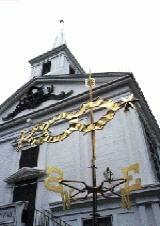Town History
The History of the Town of Tisbury
1671 to 2002
The Settlement of Tisbury was chartered by the Governor General of New York, Francis Lovelace, on July 8, 1671, during and under the reign of King James, Duke of York, England. It comprised approximately what is now known as Tisbury and West Tisbury.
The current town seal represents the quitrent paid under the terms of the charter, which was an acknowledgement of the dominion of the Duke of York over the Vineyard and other islands: "Six barrels of marketable codfish, viz, two barrels each Patent, measuring two each for Edgartown, Tisbury, And the Manor of Tisbury, to be paid at the bridge in New York, annually." The word Takemmy, which appears on the seal, is the name that the Indians used to describe the Island.
Tisbury is named for Martha's Vineyard Governor Mayhew's home town in Wiltshire, England. Around 1673, the settlers of the Vineyard grew disenchanted with the governance of Governor Mayhew and petitioned the new governor of New York, appointed by William and Mary, the rulers of England at the time, for a change in leadership. Shortly thereafter, the Island was attached to Massachusetts by the new rulers
Tisbury was incorporated as a town in 1671.
What we know as the town of Tisbury was originally known as Homes Hole, and then Holmes Hole. By 1850, the village of Holmes Hole had become a thriving community, partly due to the harbor's marine railways which were capable of hauling large vessels, a sail-loft, ship-chandleries, and two boat-yards on Lagoon pond.
In 1892, the old settlement of Tisbury was divided into two towns by an act of legislature. Thus came into being the villages of Tisbury and West Tisbury.
Dedicated to the Residents of Tisbury


